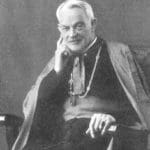THE MAGNIFICAT: Part IV of IV
“He hath received Israel His servant, being mindful of His mercy. As He spoke to our fathers, to Abraham and to his seed for ever.’ And Mary abode with her about three months, and she returned to her own house.” Luke 1:54-56
1. At the close of the canticle Mary again very emphatically reveals to us the material source of all her inspiration. She has always dwelt upon the past. She has watched the continued  faithfulness and mercy of God, “ruling from end to end mightily, and disposing all things sweetly” making “all things co-operate to good for those who love Him” even though His ways are not our ways,” and it is only afterwards, when everything is seen in its right perspective, that the great truth of His tender-hearted goodness guiding all is brought home to us. Mary sees all in this perspective; how at the beginning God “received” i.e., “chose,” “took hold of,” the people of Israel, her words echoing those of Isaiah: “But thou Israel, art my servant, Jacob, whom I have chosen, the seed of Abraham my friend,” and handing on the contemplation to St. Paul, who says: “Nowhere doth He take hold of the angels, but of the seed of Abraham he taketh hold.”
faithfulness and mercy of God, “ruling from end to end mightily, and disposing all things sweetly” making “all things co-operate to good for those who love Him” even though His ways are not our ways,” and it is only afterwards, when everything is seen in its right perspective, that the great truth of His tender-hearted goodness guiding all is brought home to us. Mary sees all in this perspective; how at the beginning God “received” i.e., “chose,” “took hold of,” the people of Israel, her words echoing those of Isaiah: “But thou Israel, art my servant, Jacob, whom I have chosen, the seed of Abraham my friend,” and handing on the contemplation to St. Paul, who says: “Nowhere doth He take hold of the angels, but of the seed of Abraham he taketh hold.”
2. “As He spoke to our fathers.” Mary’s vision is that of the student as well as of the saint. God could, she tells herself, have done otherwise. He could have brought about the redemption by other ways than this, less humiliating to the Son of God. But He has chosen this means, and having chosen it, nothing in the world shall make Him change–not the dejection, repeated and repeated, of His own people, not the faithlessness of individuals, generation after generation. Whatever else God seems to be with man, behind all the seeming He has proved again and again that His promises are sure, His word is true; and in return He does but ask that man should believe and hope. Mary sees well enough the tottering of this world. She sees the tottering of man upon its heaving surface. She sees the hand held out from the skies to hold man up. And she reminds man that that hand has never failed anyone who has grasped it.
3. Thus the Magnificat sums up, in a great outburst of thanksgiving, man’s history in the past and man’s history in the future, and centres it all upon the Incarnation, and upon her whom “all generations shall call blessed.” It describes to us the ways of God’s dealings with man, which are not as man’s ways, by means of lowliness, by elevation of the downtrodden, not by the means of which man makes most account. The Church takes up the song; she sings it in her Office every evening throughout the year; reminding herself and her children of this glorious aspect of the world’s history, and of her by whom this aspect has been made known. And in it she sees the record of her own ultimate triumph; not merely at the end of all, but in each succeeding day she knows that in her lowliness, by her suppression, through her very hungering after justice, the work of God is being done.
Summary Meditation Points:
1. “He hath received Israel his servant, being mindful of His mercy.” Mary dwells at the end on the perfect faithfulness of God, which is the greatest fruit of His mercy.
2. In that faithfulness, proved beyond any doubt to one who sees aright, she sees the basis of endless confidence under all circumstances, in all times.
3. The Church accepts the message, and repeats it every day, for herself and for every individual. “God is faithful,” says St. Paul, “who will not suffer us to be tempted beyond that which we are able.”
 Editor’s Note: This meditation is from Archbishop Alban Goodier’s “The Prince of Peace” (1913).
Editor’s Note: This meditation is from Archbishop Alban Goodier’s “The Prince of Peace” (1913).
Art for this post on the Magnificat: Visitation Detail of Umarmung Maria und Hl. Elisabeth, im Hintergrund Anna [Mary and Holy Elisabeth Hug, (St) Anne in the Background], Jacopo Pontormo, 1528-1529, PD-Worldwide, Wikimedia Commons. Mirror of Archbishop Alban Goodier, S.J., www.stmaryscadoganstreet.co.uk, all rights reserved, used with permission.





